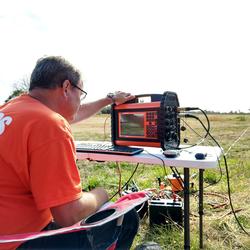Groundwater Monitoring
Groundwater Monitoring
Filter Total Items: 60
Geohydrology of the Valley‐fill Aquifer in the Lower Fall Creek Valley, Town of Dryden, Tompkins County, New York
PROBLEM The valley‐fill aquifer in the lower Fall Creek valley (designated as aquifer 4, fig. 1), within the Towns of Dryden and Groton, was mapped by Miller (2000) and identified as one of 17 unconsolidated aquifers in Tompkins County that need to be studied in more detail. The east end of the valley (near the Tompkins and Cortland County border) is on the backside of a large morainal plug, which
Groundwater-Quality of Nassau County, Long Island, New York
Problem Statement There are over 1.3 million residents in Nassau County that rely on groundwater as their sole source of potable drinking water. The mixed land uses (residential, commercial, industrial, agricultural, and recreational) of Nassau County contribute point and non-point sources of aquifer contamination. Nassau County water purveyors currently operate supply wells screened in the upper
Hydrogeologic and Geochemical Assessment of the Effects of Leakage from the Catskill and Delaware Aqueducts on the Local Bedrock and Overburden Aquifers in Southeastern New York
PROBLEM As part of an effort to sustain a viable water-supply system for 8 million residents in New York City, and 1 million other residents in upstate New York that rely on City water, the New York City Department of Environmental Protection (NYCDEP) has requested a multi-disciplinary study by the U.S. Geological Survey (USGS) to determine the source(s) of water to surface-water sites (springs
Current Water Conditions in New York
• National Water Information System (NWIS): Find water-resources data collected at approximately 1.5 million sites, using menu-based and map-based front ends. • WaterWatch: View maps, graphs, and tables describing real-time, recent, and past streamflow conditions for the United States.
Groundwater Sustainability of the Long Island Aquifer System
Groundwater sustainability can be best defined as the development and use of groundwater in a manner that can be maintained for an indefinite time without causing unacceptable environmental or socioeconomic consequences. Informed management of the Long Island aquifer system can help ensure a regionally sustainable groundwater resource. The USGS and New York State Department of Environmental...
Hydrogeologic-Framework Mapping - Long Island, New York
Home Long Island is underlain by unconsolidated Holocene deposits, glacial deposits of Pleistocene age, and coastal-plain deposits of Late Cretaceous age. These sediments consist of gravel, sand, silt, and clay underlain by crystalline bedrock of early Paleozoic age (fig. 1). The bedrock is relatively impermeable, and forms the base of the groundwater-flow system on Long Island. The geologic and...
Saltwater-Interface Mapping - Long Island, New York
Home Saltwater intrusion is the most common type of water-quality degradation in coastal-plain aquifers. In coastal areas, the hydraulic head under predevelopment (nonpumping) conditions is higher on land than in the surrounding saltwater embayments; thus, fresh groundwater flows seaward (from areas of high potential to areas of lower potential) and meets saltwater at an equilibrium point...
Groundwater-Flow Modeling - Long Island, New York
Home Numerical models provide a means to synthesize existing hydrogeologic information into an internally consistent mathematical representation of a real system or process, and thus are useful tools for testing and improving conceptual models or hypotheses of groundwater-flow systems. The goal of this effort is to develop a regional model for the Long Island aquifer system to simulate changes in...
Groundwater Sustainability - Long Island, New York
Home Groundwater sustainability can best be defined as the development and use of groundwater in a manner that can be maintained for an indefinite time without causing unacceptable environmental or socioeconomic consequences. Informed management of the Long Island aquifer system can help ensure a regionally sustainable groundwater resource. This study will evaluate the sustainability of Long...
Monthly Hydrologic Conditions for New York
The U.S. Geological Survey New York Water Science Center’s monthly summary reports and tables of hydrologic conditions for surface and ground water list the station, county, period of record, and several statistics, including color-coded percent exceedance* categories based on average monthly conditions for the period of record at each station.
Our Science
The New York Water Science Center conducts research and investigations used across a broad range of industries and other services.
U.S. Geological Survey Hydrologic Monitoring on Long Island, New York
The U.S. Geological Survey (USGS) is a science organization that provides impartial information on the health of our ecosystems and environment, the natural hazards that threaten us, the natural resources we rely on, the impacts of climate and land-use change, and the core science systems that help us provide timely, relevant, and usable information.












